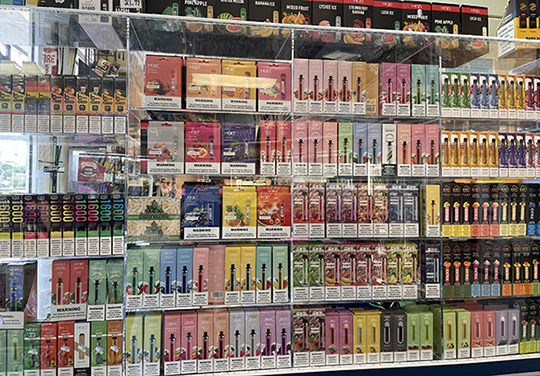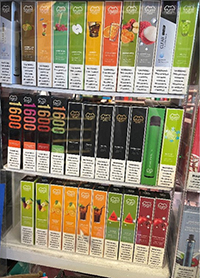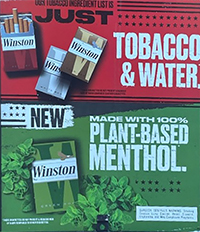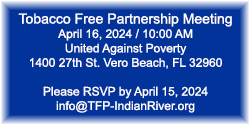News and Events
Local Surveillance of Retailers Shows the Need for Local Tobacco Retail Licensing
by Kyleigh Savoie
March 17, 2021
You have probably seen countless retail locations that have tobacco advertisements outdoors and throughout the store. You have also probably walked into a store and immediately noticed the “tobacco wall” behind the cash registered. As you read those statements, a couple of stores might have even come to mind.

Tobacco advertisements at retail locations have become commonplace, and that is a problem. The tobacco industry spends 9.5 billion dollars a year marketing its products, with a majority of that budget allocated at the point of sale. In Florida alone, the tobacco industry spends 600 million dollars (1). With this money, the tobacco industry can control every aspect of the advertisements that you see at the store, from the location, types of ads, and even pricing (2).
| The next time you walk into a store, I challenge you to look at where these advertisements are located, chances are, you will find them in close proximity to candy or youth-oriented products. This is because these advertisements have a purpose; to attract youth users to their products. |
|
The Tobacco Free Partnership of Indian River County spent several weeks looking at the types of tobacco products and advertisements that are in our store. One of the products that have grown in popularity among youth has been electronic cigarettes. And it comes to no surprise, that the products that were near candy or at the clear front of all tobacco displays, were electronic cigarettes.
Currently, one in four high schoolers reports using an electronic cigarette device (3). The significant reason for the popularity of these devices is the use of kid-friendly flavors and packaging. Flavors are often listed as one of the top three reasons for youth trying these products (4). It is also important to note that youth who are exposed to advertisements at the retail point of sale at least twice are week are twice as likely to start using tobacco products (5). These tactics, coupled with advertisements close to schools and high retailer density, contribute to an increased risk that youth will start using tobacco products. |
 |
As a community, there are steps we can take to protect our youth from industry tactics and future nicotine addiction. A local tobacco retail license gives communities control over how tobacco is sold within the community. It can be useful in reducing the number, location, density, and types of tobacco retail outlets. It can also limit point-of-sale advertising and product placement; and require retailers to comply with other tobacco control measures (6). A tobacco retail license also gives the community the ability to address emerging products such as electronic cigarettes and restrict flavors of these products.
The Tobacco Free Partnership of Indian River County is continuing to work towards bringing awareness to the industry's tactics to attract youth to their deadly products. Our Partnership is actively working to educate community members surrounding the benefits of a local tobacco retail license. If you would like more information on our program or responsible tobacco retailing, please reach out to Kyleigh Savoie at ksavoie@quitdoc.com.
_________________________________________________________________
References:
- U.S. Federal Trade Commission (FTC), Cigarette Report for 2017, 2019, https://www.ftc.gov/system/files/documents/reports/federal-tradecommission-cigarette-report-2017-federal-trade-commission-smokeless-tobacco-report/ftc_cigarette_report_2017.pdf [data for top 5 manufacturers only].; FTC, Smokeless Tobacco Report for 2017, 2019, https://www.ftc.gov/system/files/documents/reports/federal-tradecommission-cigarette-repo.
- Feighery, E, et al., "Cigarette advertising and promotional strategies in retail outlets: results of a statewide survey in California," Tobacco Control 10:184-188, 2001.
- Tsai J, Walton K, Coleman BN, et al. Reasons for Electronic Cigarette Use Among Middle and High School Students — National Youth Tobacco Survey, United States, 2016. MMWR Morb Mortal Wkly Rep 2018;67:196–200. 3.
- Myers AE, Hall MG, Isgett LF, Ribisl KM. "A comparison of three policy approaches for tobacco retailer reduction. https://www.ncbi.nlm.nih.gov/pubmed/25689540.
- Henriksen, L, et al., "A longitudinal study of exposure to retail cigarette advertising and smoking initiation," Pediatrics126:232-238, 2010. http://pediatrics.aappublications.org/content/pediatrics/126/2/232.full.pdf?download=true. Florida Youth Tobacco Survey (FYTS), Florida Department of Health, Bureau of Epidemiology, 2020.





